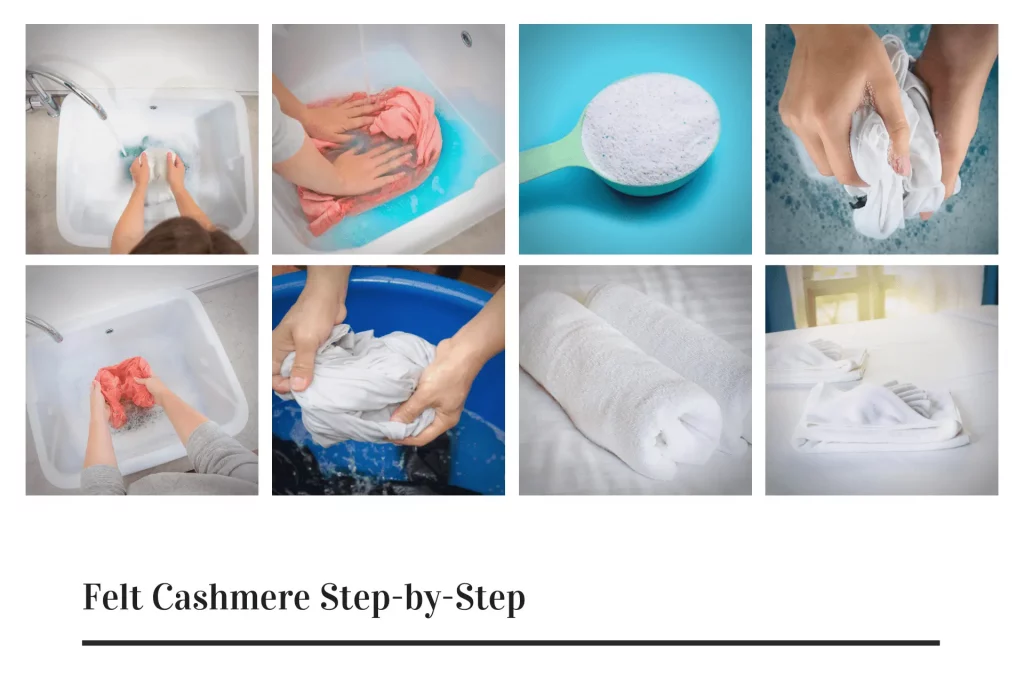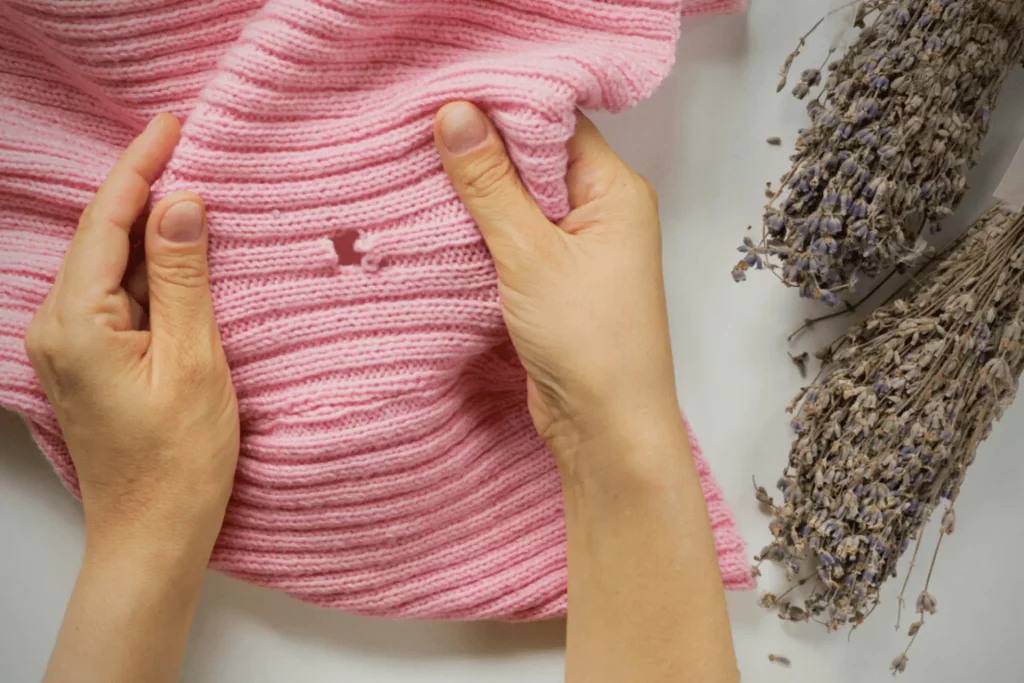Cashmere is an excellent choice if you want to acquire an opulent and one-of-a-kind fabric. Cashmere is a type of fabric that is famous for being exceptionally warm and supple. It is derived from the downy undercoat of cashmere goats.
Because cashmere is so fragile, working with it can be challenging. The cashmere should be felted before any work is done with it. This is one approach to get around the problem.
When you want to feel cashmere, you should begin by placing a piece of bubble wrap on top of the cashmere cloth. First, wet the cashmere by spraying it with warm water from a spray bottle, and then rub the two pieces of fabric together to generate friction.
The damp cashmere should then be covered with an additional layer of bubble wrap before being rolled up securely. After that, heat the rolled-up cloth in the microwave for two to three minutes at high power.
Allow the cashmere to cool for a few minutes after being heated in the microwave before unrolling it. You should see that the cashmere has become more felted and has a smaller size. You may put it to use for your project right now!
Table of Contents
How to Felt Cashmere? Step-by-Step Guide

Cashmere is a beautiful material to work with if you are searching for something plush and cozy at the same time. Cashmere is characterized by a high degree of pliability and a low level of weight. It is obtained from the downy undercoat of cashmere goats. A few processes need to be followed to felt cashmere successfully.
- Place the cashmere sweater you want to wash face down on a surface you don’t mind getting wet. A sink is a viable alternative to a bathtub or shower, which are also possible options.
- Soak the sweater in warm water, and use your hands to ensure that it is thoroughly and evenly soaked.
- Using your hands again, apply a tiny quantity of dish soap or wool wash to the damp sweater, and then distribute it evenly all over the shirt.
- Make a lather out of the soapy cashmere by rubbing it between your palms to create a foam. Cover the whole garment since you do not want any uncovered areas!
- Remove any traces of detergent from the cashmere by rinsing it well with warm water, ensuring to wet the sweater thoroughly this time.
- Remove excess water from the cashmere by squeezing it gently; do not wring it or twist it since these actions might harm the fibers in the cashmere.
- Place the wet cashmere on a towel and wrap it into a burrito shape with the towel. To assist in the sweater’s ability to absorb additional water, apply slight pressure to the towel-wrapped item.
- After unrolling the towel, place the cashmere sweater flat on top of another dry towel. You may return it to its former form by shaping it with your hands; however, you should avoid overstretching or pulling it since this can also cause harm to the fibers.
- Before wearing the cashmere sweater or putting it away, you should give it ample time to air dry. If you are short on time, you may speed up the drying process by using a setting on your hair drier that has a lower heat setting.
You’ve successfully learned how to feel cashmere, so congratulations! With just a few easy steps, you can make your favorite sweater last much longer and ensure that it retains its pristine appearance for many years.
How to Felt Cashmere in the Washing Machine?
You’ve found the perfect site if you wonder whether or not it’s possible to feel cashmere in the washing machine. Adding interest and texture to your knitting creations with felted cashmere is a simple process that can be done in a matter of minutes.
This is everything you will need to get started:
- A washing machine
- Spun from cashmere.
- A couple of worn-out handtowels
- A pair of stockings, often known as pantyhose (optional).
You will need to collect all the necessary components to get started. In addition to a few used towels, you will need to ensure sufficient cashmere yarn to cover the area you intend to feel.
If you wish to wear pantyhose or tights while you’re felting, you’ll need to bring those along with you. They can help you maintain more control over the process.
Felting may begin as soon as you have acquired all the necessary materials. To begin, soak your cashmere yarn and wring it out until it is moist but not dripping wet.
This will be the starting point for your project. Then, put the old towels and the yarn in the washing machine and wash everything together. If you wear pantyhose or tights, you should put them in the washing machine together with the rest of your clothes.
Adjust the water temperature on your washing machine to the highest setting, and use the most extended cycle. Allow the process to run its entire course, and check on your cashmere regularly to ensure that it is felting to the extent you want it to. When you are through, rinse your cashmere in lukewarm water, then lay it out to dry in a flat position.
And that brings us to the end of our discussion! Adding texture and interest to your knitting creations is as simple as throwing cashmere into the washing machine to feel it. This is a quick and easy method. If you’re looking for a fun new way to spice up your yarn, give it a shot the next time you’re in the market for one!
How to Felt Old Cashmere Sweaters?

Don’t give up hope if you have an old cashmere sweater that has seen better days than it has now! Felting it will breathe fresh life into the material. The process of felting involves fulling, also known as shrinking, the fabric to make it denser, thicker, and more long-lasting. Because cashmere is made of fine material, it works wonderfully with this.
To felt your sweater, you will need to submerge it in hot water and wring it out repeatedly until the fibers condense and tangle. One can either do this by hand or using a washing machine.
It is important to remember to measure the sweater before you start the felting process because once it is finished, the shirt will be significantly shorter and smaller than its initial size.
When working with cashmere, it is essential to utilize hot water in the felting process. The speed at which the felting process is completed is directly proportional to the temperature of the water. You should also add some soap to the mixture to assist the fibers in shrinking and coming together to form a mat.
After your sweater has been thoroughly wetted and lathered with soap, it is time to begin agitating it. You have the option of doing this manually or using a washing machine. Squish the sweater around in the water until it begins to feel as if you are doing it by hand. This might take some time, so please be patient with us!
If you are using a washing machine, ensure the water temperature is set to the highest possible level, and then place the sweater in the device by itself. Please wait for it to go around once more, then check on how far along the felting process it is.
You may need to add another cycle if the felting process is not progressing quickly enough. If you do too much, your sweater can end up too small. Just be careful not to overdo it.
Rinsing your sweater in cold water will halt the felting process after it has reached the appropriate thickness of your shirt after it has been felted. After that, mold it into its new form and let it dry completely.
Now that you know how to feel cashmere sweaters put this skill to good use and give some of your old favorites a new lease of life by giving them a felted texture.
How to Felt Cashmere: Tips and Tricks
Now that you understand how to feel cashmere, I will share with you a few pointers and suggestions that will assist you in making the most of this beautiful fabric.
To get the most wear out of your cashmere and keep it looking its best, wash it by hand in cold water with a gentle detergent. It would help if you avoided wringing or twisting the cloth to prevent the fibers from becoming damaged. Instead, remove the excess water from the cashmere by pushing it before putting it flat to dry.
If you must iron your cashmere, do it on a low setting and shield the fibers from the direct heat using a pressing cloth.
If you want to store your cashmere, roll it up loosely and put it somewhere cold and dark. Because moths attract cashmere, you should always keep it in a container or bag that is hermetically sealed while it is not being used.
When shopping for cashmere, you should search for pieces manufactured from cashmere fibers that are unmixed with any other threads. These will be softer than mixes while yet being more durable.
These pointers will allow you many years of use out of your cashmere!
Frequently Asked Questions:
What to do with old cashmere sweaters?
You should give them to a charity or a thrift store. This is a fantastic opportunity to assist needy people while extending your sweater’s helpful life.
How does one go about the process of felting?
The layers of wool are sprayed with hot water, and occasionally, detergent is added to the water. The layers are then subjected to repetitive agitation and compression, which causes the wool fibers to hook and mesh together into one piece of fabric. Wet felting can only be done successfully with particular types of fiber.
Is felting difficult?
The fundamentals of needle felting are simple to grasp, and beginner kits sold in craft stores come with all the equipment and ingredients needed to get started, including the raw materials required to create felted wool. Particular felted wool creatures are more challenging to develop than others, and it takes some effort to make their faces, and other characteristics look genuine.
Bottom Line:
Don’t worry if you still aren’t sure how to feel cashmere; there are plenty of different ways to felt woolen materials outside the traditional method. You could want to consider using a washing machine, for example. Ensure that the cashmere is secured within a mesh bag before continuing the process to prevent it from being entangled.

